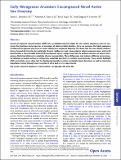Early nitrogenase ancestors encompassed novel active site diversity
Author(s)
Schwartz, Sarah L; Garcia, Amanda K; Kaçar, Betül; Fournier, Gregory P
DownloadPublished version (480.8Kb)
Publisher with Creative Commons License
Publisher with Creative Commons License
Creative Commons Attribution
Terms of use
Metadata
Show full item recordAbstract
<jats:title>Abstract</jats:title>
<jats:p>Ancestral sequence reconstruction (ASR) infers predicted ancestral states for sites within sequences and can constrain the functions and properties of ancestors of extant protein families. Here, we compare the likely sequences of inferred nitrogenase ancestors to extant nitrogenase sequence diversity. We show that the most-likely combinations of ancestral states for key substrate channel residues are not represented in extant sequence space, and rarely found within a more broadly defined physiochemical space—supporting that the earliest ancestors of extant nitrogenases likely had alternative substrate channel composition. These differences may indicate differing environmental selection pressures acting on nitrogenase substrate specificity in ancient environments. These results highlight ASR's potential as an in silico tool for developing hypotheses about ancestral enzyme functions, as well as improving hypothesis testing through more targeted in vitro and in vivo experiments.</jats:p>
Date issued
2022Department
Massachusetts Institute of Technology. Department of Earth, Atmospheric, and Planetary SciencesJournal
Molecular Biology and Evolution
Publisher
Oxford University Press (OUP)
Citation
Schwartz, Sarah L, Garcia, Amanda K, Kaçar, Betül and Fournier, Gregory P. 2022. "Early nitrogenase ancestors encompassed novel active site diversity." Molecular Biology and Evolution, 39 (11).
Version: Final published version